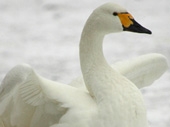Last Swan leaves Slimbridge

Hosta, the last Bewick’s swan left in Gloucestershire, has finally left the Wildfowl and Wetlands Trust (WWT) Slimbridge Wetland Centre on her spring migration, a month after the rest of the reserve's flock departed!
Hosta will now be on route across eastern Europe on her way to the high artic tundra of Russia where she, along with other northwest European wintering Bewick’s swans, will spend the summer.
Julia Newth, wildlife health officer for WWT, said: “After developing a remarkably strong bond with the captive group in the Tundra Pen, the lengthening days will have provided the main stimulus for triggering her migration. The swans migratory and reproductive cycles must be closely synchronised as the birds have just 3-4 months in which to breed, moult, develop fat reserves and head back to Europe before the arctic winter closes in again. “
Over the course of the winter, 240 individual swans visited WWT Slimbridge which was much lower than the reserve's five-year average (322 birds). A co-ordinated international census in 2010 will confirm the status of the population and indicate whether there has been a decline and/or a redistribution of birds across the flyway.
Poor breeding success will have reduced recruitment to the population in recent years and sadly, 2008 was no exception. Only 7.5% of the Slimbridge flock were juveniles this winter and even lower productivity was found on the continent, with only 4% found in 3,000 birds aged in the Netherlands in November (Wim Tijsen). The weather on the tundra is likely to be very influential in determining breeding success with late spring thaws (as seen in spring 2009) being particularly detrimental.
Julia added: “As the swans make their way across Europe on their epic journey, we hope for much improved breeding success once they start arriving in the arctic in June and look forward to hearing of their progress as they make their way back to us in the autumn.”
Explore Gloucestershire
9 April 2009
For further information.
OTHER NEWS
